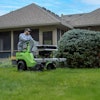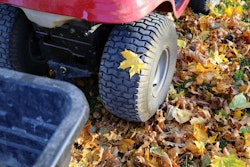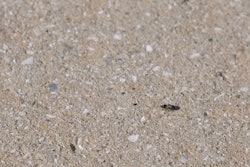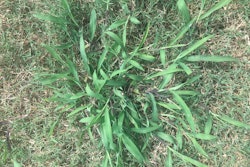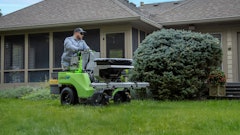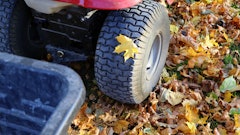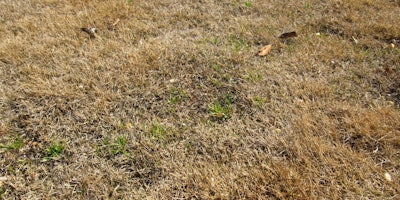
Winter lawn care for a wide variety of turfgrasses slightly differs from that of spring, summer and fall. Your lawn is no longer in the active growing season. In fact, most warm season lawns go dormant around this time.
Lawn care in the winter is still just as important as other seasonal maintenance practices as your winter care will greatly determine how well your lawn comes out of dormancy in the spring.
Although you shouldn’t have to spend as much time maintaining your lawn during the active growing season, winter lawn maintenance is still a vital part of caring for your lawn.
How to Mow Your Lawn in the Winter
It’s getting cooler outside and it’s obvious that you won’t need to mow as frequently as you have been all year. Our recommendation is to keep your grass a bit taller than normal.
When grass is too short, it doesn’t offer as much protection for the base of the grass blades and allows frost to get into the growing areas of your lawn. Keeping this area as protected as possible with slightly taller grass creates a barrier-like protection for the grass blades and stolons.
Be careful not to mow your lawn if there’s a lot of moisture from snow or ice as this may damage the grass blades. Make sure the lawn is dry and only mow when temperatures are about 40 degrees Fahrenheit.
Now is an excellent time to service, or winterize, your lawn mower so that it’s fully operational and ready for the spring once mowing season resumes!
How to Water Your Lawn in the Winter
Irrigation maintenance practices during the winter aren’t usually as important in areas that receive rain or snow. In most areas, you will just need to water your lawn less than the active growing season.
However, if you are in an area that receives a really dry winter, be sure to water your lawn enough so that the soil receives nourishment and keeps grass blades from drying out. Your lawn is dormant—this doesn’t mean it is dead and doesn’t still need water.
The Best Winter Fertilizer for Lawns
Fertilization should generally take place during the active growing seasons such as the spring, summer and fall. There is really not a need to apply fertilizer once temperatures consistently drop below 40 degrees Fahrenheit. It’s similar to giving someone a pill while they are sleeping—it won’t be as effective.
It’s best to prepare your lawn with the nutrients it needs to survive winter dormancy during the fall.
However, when spring comes, it will be time to fertilize your lawn. Researching different fertilizers that match your lawn’s needs is something you can go ahead and start doing.
Watch for Winter Weeds
Keep an eye out for winter grass weeds. Applying an herbicide during the winter isn’t always effective since your lawn is dormant, which is why it’s best to apply products preventively in the fall.
Some research has shown that it’s safe to apply glyphosate, a non-selective herbicide, on dormant bermuda grass to kill off other weeds without damaging the bermuda grass. The efficacy of this is not as high as it would be in warmer temperatures, but it can still be done when applied properly.
If you have a lot of weeds, make note to apply a pre-emergent herbicide in the fall next year to prevent them. Common winter weeds to look out for include:
- Purple Deadnettle
- Chickweed
- Annual bluegrass (Poa annua)
- Henbit
Weed control products and other winter lawn treatments aren’t as effective in the winter as other times of the year, which is why it’s best to apply these products preventively in the fall season before temperatures get too cold. Read and follow product labels thoroughly.
Winter Lawn Insects to Look Out For
Most pests are going to be inactive at this time since it’s so cold outside. However, oftentimes insects and pests will burrow under objects in the lawn like lawn ornaments, toys that have been left out, weeds, rotted branches, etc.
A good way to keep them from overwintering in your lawn and causing damage in the spring again is by removing a lot of these objects from your lawn so that pests don’t have a place to take shelter from the cold.
Either hand-pull or apply a post-emergent herbicide to keep any weeds that have survived cooler temperatures and consider relocating any lawn objects to your garage or outdoor shed.
You can also apply a broad-spectrum insect control product to treat any insects or bugs you may spot in the meantime.
Certain insects like grub worms, ants, fleas, ticks, chinch bugs and spiders are sometimes known to survive during the colder parts of the year if they have places to take shelter.
Insect control products aren’t as effective in the winter as other times of the year, which is why it’s best to apply these products preventively in the fall season before temperatures get too cold. Read and follow product labels thoroughly.
How to Control Lawn Disease in the Winter
It’s pretty difficult to detect most lawn diseases during the winter season—especially if you have a warm season lawn that goes off-color and dormant as temperatures drop.
Oftentimes, symptoms of disease don’t begin making an appearance until the spring as the lawn greens up and disease patterns are easier to distinguish.
It’s still a great idea to apply disease control products preventively during the fall to keep diseases from taking over during the winter season. You may still notice some lawn diseases like snow mold.
Disease control products aren’t as effective in the winter as other times of the year, which is why it’s best to apply these products preventively in the fall season before temperatures get too cold. And as always, read and follow product labels thoroughly.
Avoid Excessive Traffic
Your grass is probably dormant, meaning it’s not going to put a lot of energy into restoring itself after heavy traffic. Taking as much care of your lawn as you can by reducing traffic while it is “asleep” is one of the best preventative maintenance practices you can perform.
It keeps your grass from having to spend a bunch of energy restoring itself when it comes out of dormancy. Instead, let your grass focus its energy on flourishing as it comes out of dormancy.
Installing Sod in the Winter
Are you thinking about installing grass in the winter? Not always a problem. The good news is this is entirely possible depending on your geographic location. Check your location and climate as a personal guide.


